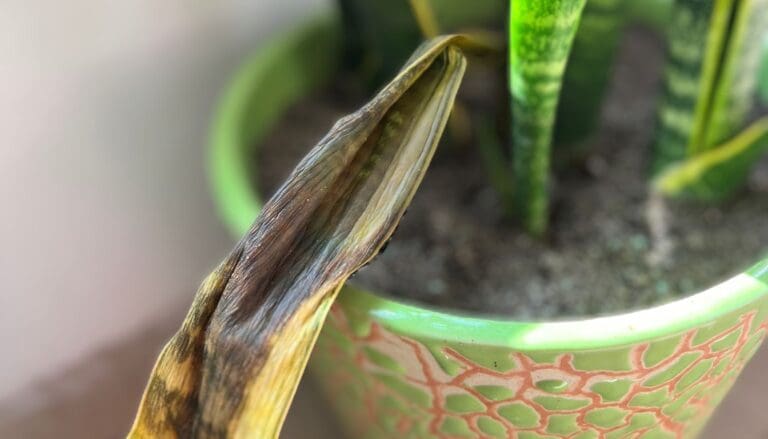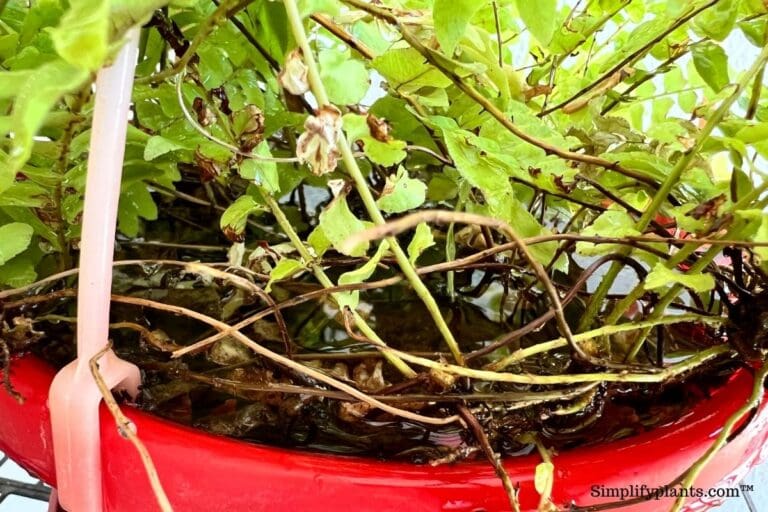Do Monstera Like To Be Root Bound? (+When To Repot)
Monsteras are famous indoor plants with unique fenestrations. Gardeners often keep them in small pots, thinking it encourages faster growth when they become rootbound. But do Monsteras like being rootbound?
Monsters don’t like being rootbound, as the roots need growing space. When wrapped, the roots struggle to pass moisture and nutrients, leading to stress, stunted growth, and pale leaves. To prevent this, repot your Monstera every 2 years during active growth.
Are you a newbie with a rootbound Monstera? Keep reading to learn if Monsteras like being rootbound, the signs of a rootbound plant, how to fix it, and tips for healthy growth.
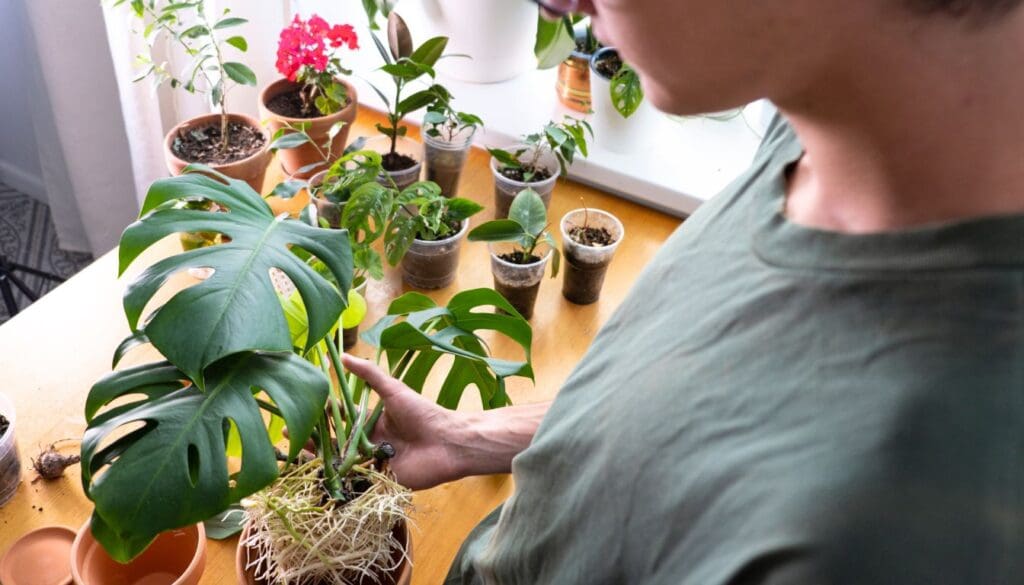
Please note: Simplify Plants is reader-supported. Some links in the post are affiliate links and I get a commission from purchases made through links in the post.
Do Monsteras like to be rootbound?
Monsteras, or Swiss Cheese plants, exhibit growth patterns similar to other plants.
The roots take up the air, water, and nutrients and transfer them to the other plant parts to develop stems and leaves, make food, and encourage good growth.
As the plant size increases, it needs more food, for which the roots expand to meet these needs and transfer adequate nutrients and moisture.
If roots lack space to expand, they tend to grow in a circular motion to develop.
So they start growing in a circular motion and bind together by wrapping each other.
It is called rootbound, and Monsteras don’t like to be rootbound.
The roots keep taking up the pot’s space, leaving less room for soil, moisture, and oxygen.
When roots wrap around each other, they become highly compact, further making them struggle to transfer moisture and nutrients and disturbing their growth and development.
With limited soil, the plant struggles to access sufficient nutrients and moisture.
Due to the less medium, water goes straight out of the drainage hose.
All these will stress the Monstera significantly, stop their growth, weaken them, and make them susceptible to pests and diseases.
Signs of a rootbound Monstera
We know that Monstera doesn’t like to be rootbound. But how do you understand if it’s rootbound?
Monsteras express their stress through a few signs, which helps us know what is wrong with it in the first place.
Identifying these signs is essential so that you can take immediate action and save it from suffering. Let’s assess these signs:
- The roots come out of the drainage holes when the room inside the pot becomes insufficient for them.
- The roots begin to peek out from the soil surface.
- The leaves start curling and wilting as the roots struggle to transfer moisture and nutrients.
- The plant stops growing.
- Since the roots take up the space, the amount of soil reduces.
- Less soil dries out faster. The Monstera looks dehydrated and has too many yellow and brown crispy leaves.
- The roots have expanded so much that your pot will swell and crack in places.
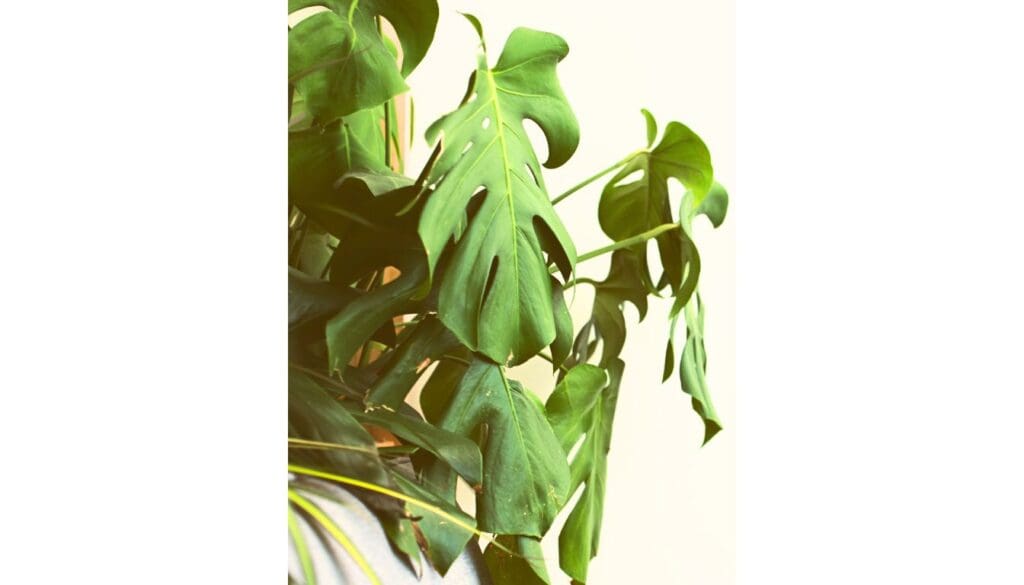
Inspect the roots to gauge the level of compaction in your Monstera
Once you have noticed the signs, it is time to confirm the issue by examining the roots.
Take out the plant carefully with the following steps:
- Begin with watering the plant so the soil gets wet, and unpotting the plant becomes easier.
- The plant won’t be out if the roots are caught in the drainage holes. Cut off these protruding roots with a sharp and sterile knife or scissors. Avoid bruising, infecting, or exposing them to the pathogens.
- Run a knife at the pot edges to loosen the soil. Don’t pull your plant. Slowly, take out the plant.
Once it’s out, understand the compaction level.
If only a few roots are wrapped around the rootball, it is slightly rootbound.
If there are mats around the rootball, the compaction level is moderate.
At these stages, you may repot it immediately or wait longer.
However, it is better to repot at the moderate stage because the Monstera can get potbound severely in no time.
In worse conditions, the mats will be very thick, and you won’t be able to see any soil around the root ball of your Monstera.
Repotting or splitting the rootbound Monstera is mandatory.
Repotting to fix a rootbound Monstera

Once you have confirmed that your Monstera is rootbound, the best way to fix it is to repot the Monstera.
Step 1: Take out your Monstera from the pot
First, slowly take out the Monstera from the pot. It’s the exact steps you follow while examining the roots (already explained earlier).
Water the plant 1-2 days before, tap the pot sides, run a knife around the pot edges, and slowly remove the plant.
If needed, cut off the roots from the drainage holes to make removal easier.
Step 2: Disentangle the Monstera roots and trim some if needed
Remove maximum soil from your Monstera plant’s roots and root ball to examine their condition.
If the roots of your Monstera are too entangled, slowly remove the dense tangle with your hand or use a knife to cut off the excessively entangled roots.
Prune the damaged, mushy, and discolored roots. You may also trim off the extremely long and thin roots.
Step 3: Use the right and fresh potting mix for Monstera
Next, choose the soil mix for repotting the Monsteras.
Since it’s been years, the old soil has depleted, and it’s time to provide the plant with a fresh, nutritious potting mix to boost their growth.
Use a well-draining potting mix that retains enough moisture, is fertile, and has a pH of 5.5-6.5.
There are several options in both commercial and DIY mixes.
Two of my best suggestions would be:
- 1 part peat, 1 part coco coir, and 4 parts pine bark fines.
- 1 part terrarium soil and 1 part LECA
- 2-3 parts Miracle-Gro potting mix and 1 part of large-sized perlite
You can even use 100% LECA, as it prevents overwatering and root rot.
Please go through our Monsera Soil Article for more options.
Step 4: Ideal pot size for your Monstera
Next, choose the right pot size for your Monstera plant.
Since the plant gets potbound due to the lack of space, choose a pot 2-3 inches bigger than the old one to provide enough space for root development for two years.
Make sure the pot has drainage holes to let the extra water out.
Choose terracotta pots if you overwater, as they wick moisture faster.
Use plastic if you forget to water it because it can hold moisture.
The best option is a self-watering pot, as the plant absorbs water from the attached reservoir whenever needed.
Check the reservoir regularly and add water when needed.
Step 5: Repot the Monstera
Let’s repot the Monstera.
Fill half the pot with the potting mix, make a hole at the center, and plant the Monstera.
Spread the roots evenly and then cover it with the remaining potting mix. Tap the sides gently.
Leave 1-2 inches of space at the pot’s top to apply water and fertilizers.
Once you have repotted, water the plant until the extra drains out of the potholes.
Caring after repotting a rootbound Monstera

Once your repotting is done, maintain adequate growing conditions for your Monstera:
- Keep the plant near a window providing bright indirect or medium sunlight levels. Avoid direct sun. You can use full-spectrum LED or fluorescent lights.
- Keep the soil consistently moist, and don’t water until the top few inches have dried.
- Maintain warm temperatures (65-85°F) and high humidity (40-60%) around the plant.
- Don’t fertilize for a few weeks. Begin your fertilizing schedule after noticing new growth.
You might notice reduced growth rates, yellow leaves, or defoliation.
These are signs of repotting stress.
Continue caring for your Monstera and let it adjust to the new environment.
These signs will stop as soon as the plant settles down.
To reduce the repotting stress:
- Use the same potting mix as you have used before. Make very few changes, like adding only drainage or retention materials.
- Keep your Monstera in the exact location as it was before.
- Use the same light levels, temperature, and humidity as before, provided they have worked well for your Monsteras.
Keeping these few things constant will make the Monstera think that nothing has changed, and it will quickly adapt to the new environment.
Fix a rootbound Monstera by splitting it with 7 simple steps
Another way to fix a rootbound plant is by splitting it.
In this case, you don’t need a larger pot but another pot of the same size.
Once you split, the plant size and rootball will reduce, and the existing pot will provide enough space for root development.
Make sure to divide your Monstera during the growing season.
The active growth season will encourage quick recovery and new growth.
Here are the steps to split or divide a rootbound Monstera:
- Begin with watering the Monstera and take it out.
- Find out the offshoots and the natural branches of the root ball and cut through the roots in these areas with a sterilized scissor or knife.
- You might not get enough junctions, but ensure that the scissor passes through the junction points of the stems.
- Keep enough stems, leaves, and roots with each plant division.
- Ensure to receive healthy divisions from the parent plant instead of the stressed parts.
- Fill the new pots with the potting mix and repot the plant divisions. Provide enough water, bright indirect sunlight, warm temperatures, and high humidity.
- Skip fertilizer for a few weeks for the parent plant and let it recover from the stress received from splitting. As for the new divisions, wait until you notice the new growth. Don’t worry; they will get nutrients from the new potting mixes.
Root pruning to fix the rootbound Monstera
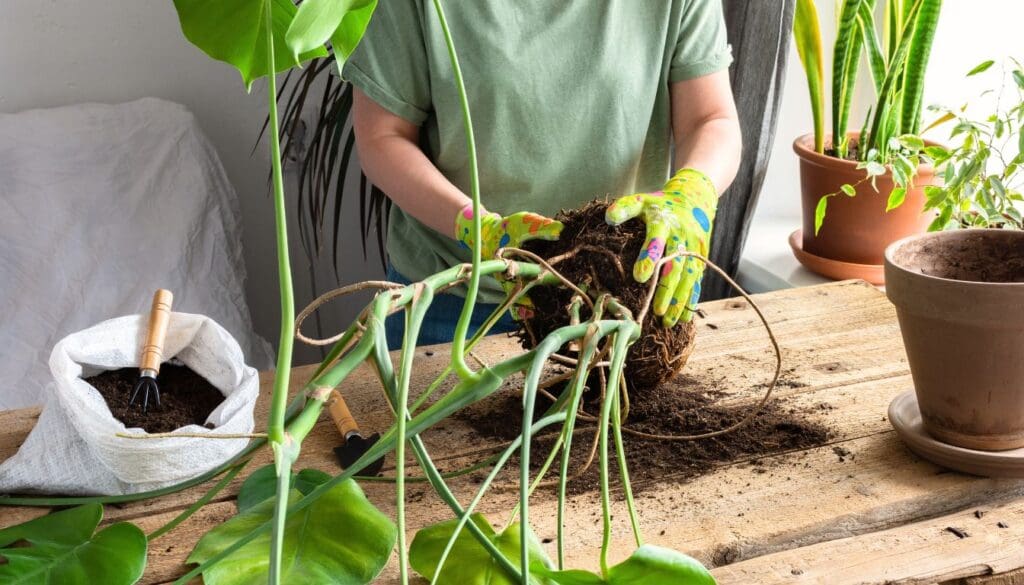
Repotting or dividing a rootbound Monstera takes time and effort.
If you don’t have time, I have another solution to fix a rootbound Monstera: Root pruning.
It will allow you to keep your plant in the same small pot for now.
The option is time- and space-saving for those living in small apartments or working in small offices.
Here are the steps:
- Remove your Monstera from the pot and check the roots.
- Cut off some circling and entangled roots from the outside part of the root system until you get a manageable mass.
- Please do not cut down the thicker roots unless they are damaged or have become brown and mushy. These roots carry adequate water and nutrition to transfer to the other plant parts.
- Focus on trimming off the long, thin, and delicate roots at the periphery of the root mass.
- Once trimmed, rinse the roots with lukewarm water and return it to the pot.
- Prune off some of the new growth from your Monstera so that the plant can focus on rebuilding the roots instead of new stems or leaves.
- You can use the trimmed parts in propagation.
- Expect signs of transplant shock after removing the plant from the pot and pruning the roots. But don’t worry. The stress in plants will be reduced soon.
Make sure to perform this during the active growth season for faster recovery and new growth.
How to prevent the Monsteras from getting rootbound?
To prevent the Monsteras from getting rootbound, you need to repot them on time before they show the advanced signs of rootbound.
So, when and how often should we repot the Monsteras to keep them from being rootbound?
There is no specific time frame to repot the Monsteras.
We know that whenever the plant shows signs of being rootbound, it is time to repot them.
But, sometimes, the signs can be displayed when it is not the right season to repot.
And, if you wait for the arrival of the active season, it might be late.
In such a case, repotting the Monstera before they exhibit too many signs of being rootbound is the best decision.
Every 2 years, when Monsteras begins its active growth, primarily in the early spring, it is the best time to repot them. It’s the only best way to prevent your Monstera from getting rootbound.
The young Monsteras must be repotted once a year because they grow rapidly to establish their root system.
Mature plants need less repotting since they have a stabilized root system.
Updating their growing medium will give them adequate moisture and nutrients to stay healthy and strong. You can repot them every 2-3 years.
Final thoughts
Monsteras become potbound when there’s not enough space in the pots for their roots. Hence, they try to grow circularly to get enough space for their expansion. Monsteras do not like to be rootbound because when roots bind, the transfer of moisture and nutrients gets hindered, and the plant gets stressed.
The signs of a rootbound Monstera are roots protruding from the drainage holes and soil surface, growing circularly, yellow and wilted leaves, stunted growth, or dehydration. To fix a rootbound plant, repot your Monstera, split the parent plant, or trim off some roots that have become extremely rootbound.
Repot the plant on time to prevent your Monstera from reaching this stage. The best time to repot the Monsteras is every 2 years during the early spring when they begin their active growth. Use a pot 2 inches bigger than the old one.
When should I split or trim the roots to fix a rootbound Monstera?
Like repotting, these two methods should be done when Monsteras have begun their active growth. It can stress the plant, and the active season will encourage them to have new growth and faster recovery.
When should I water and fertilize after fixing a rootbound Monstera?
You can water right after you have fixed the rootbound Monstera. Fertilize them after you notice new growth every 2-4 weeks during the spring and summer.
Reference: Monstera Wikipedia
Recommended Garden Supplies
| Product Image | Our Recommended Gardening Supplies | Check Offers! |
|---|---|---|
Top Top
Top
Top
Top
Top
Top
Top
Top | rePotme Houseplant and Tropical Classic Potting Soil Mix | Check Offer On Amazon |
 Top
Top
Top
Top
Top
Top
Top
Top | Espoma Organic Indoor Plant Food | Check Offer On Amazon |
 Top
Top
Top
Top
Top
Top
Top
Top | GooingTop LED Grow Light 6000K Full Spectrum Clip Plant Growing Lamp | Check Offer On Amazon |
 Top
Top
Top
Top
Top
Top
Top
Top | Soil Moisture Meter | Check Offer On Amazon |
 Top
Top
Top
Top
Top
Top
Top
Top | Govee Hygrometer Thermometer, Bluetooth Enabled! | Check Offer On Amazon |
 Top
Top | LEVOIT Humidifiers for Large Room(Best For Plants) | Check Offer On Amazon |
 Top
Top
Top
Top
Top
Top
Top
Top | Upgraded DIY Automatic Drip Irrigation Kit, 15 Potted Houseplants Support | Check Offer On Amazon |
 Top
Top
Top
Top
Top
Top
Top
Top | Stainless Steel Heavy Duty Gardening Tool Set | Check Offer On Amazon |
 Top
Top
Top
Top
Top
Top
Top
Top | Bonide Insecticidal Soap | Check Offer On Amazon |
 Top
Top
Top
Top
Top
Top
Top
Top | Bonide 32 oz Spray Neem Oil for Organic Gardening | Check Offer On Amazon |
 Top
Top
Top
Top
Top
Top
Top
Top | Garden Safe Fungicide | Check Offer On Amazon |


